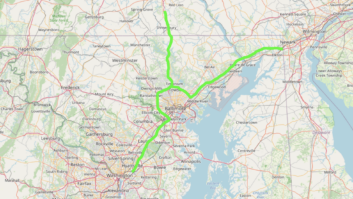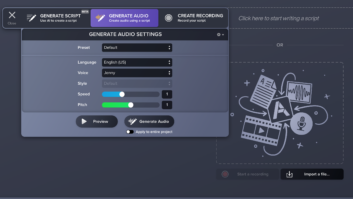Content delivery options
Apr 1, 2008 12:00 PM, By Kevin McNamara, CNE

Even new forms of audio media use the same one-way transmission scheme that radio has used since its inception.
In many ways, radio has not changed since the 1940s. Yes, the technology has become more sophisticated, the quality of the audio is better (well, depending on whom you ask) and we have transitioned to a fully digital studio and delivery system. But radio still does the same thing it has done since its inception: broadcast in a single direction. This worked fine for radio’s first 50 years, but the advent of the Internet, satellite and various wireless platforms provide a growing threat to the once mighty radio station.
As a stand-alone medium, traditional broadcasting is subject to a multitude of restrictions as compared with other Internet-driven delivery platforms. Its primary limitations include coverage area, available bandwidth and interactive capabilities. While these are significant issues, they are not impossible to overcome using some alternative delivery methods now available.
Another interesting point to consider, most of the multimedia content available to the general public is also broadcast only in a single direction, hence the terms podcast, webcast and Bluecast. The list goes on forever. Internet radio stations also broadcast in a single direction. They are really not much different, with the exception that many of the new media radio broadcasters offer users a wider range of services including video, data and on-demand capabilities.
Many stations are already streaming broadcasts on one of the many internet radio portals and on their own websites. While the current state of technology permits any person connected to the internet to broadcast audio and video, you need to be aware of the various delivery options available and some of their benefits.
Choices of delivery platforms
Just 20 years ago terrestrial broadcasting was the primary platform for the delivery of multimedia content. Times were simpler then, the biggest issues we dealt with was choosing the format to reach the most 25-54-year-olds and making sure the processors were adjusted properly for minimal listener fatigue. The Internet was arguably the reason for the evolution of the new media delivery, but still required hard connection to a network; however, in recent time, new wireless services have un-tethered access and now a variety of handheld devices and laptop PCs can access streaming media in real-time or store for use at a later time.
The FCC has recently auctioned spectrum that will allow carriers to create seamless local, regional or national wireless networks supporting higher speed voice, video, radio and data services. The handsets for these services promise to fulfill all business, personal and entertainment needs in a single device.
While the licensees for existing and emerging wireless services have or are in the process of cutting deals with content providers for custom entertainment offerings, these devices also have Internet access, which makes any online streaming media available.
Whether you are currently streaming audio or are planning to make the move it is necessary to have a basic understanding of the options for delivering the content.
Streaming multimedia
The first thing to understand is the distinction between streaming and non-streaming multimedia. Streaming describes the method of delivery rather than the specific coding method. Streaming is the process of sending an encoded datastream over a network for reception (decoding) at one or many network connected devices, basically a broadcast, i.e. Internet radio. Non-streaming delivery is content stored on a server for delivery when requested by a user, i.e. podcast, webcast. These are also called linear or non-linear delivery methods.
It is easy to understand that less bandwidth will be required to send one stream to many users simultaneously, as opposed to sending multiple unique streams to one (or many) users. In order for the multimedia files to get to the intended users there are four different types of routing schemes that can be utilized depending on factors such as bandwidth limitations, location of users and type of streaming content (single or multiple streams). There is a significant financial impact to choosing the wrong delivery method due to the cost of bandwidth; this must be closely evaluated with your provider in order to maintain maximum delivery efficiency with the lowest cost.
- Unicast � Provides streaming delivery from a single source to a single destination. This is perhaps the least economical delivery method. Since multiple users will get different streams essentially, the bandwidth required for a single stream is multiplied by the amount of concurrent users. This is also called a one-to-one relationship.
- Multicast � There are several different flavors of multicasting, but the most common is called IP multicasting. In this arrangement, a single group address is established (such as aaa.bbb.ccc.ddd). The destination nodes initiate contact with the group address which is completely opposite of traditional TCP/IP delivery. A routing tree is established when each of the destination devices establishes the connection. Using this routing tree concept is an efficient means to establish a streaming network but can be expensive when compared to other means. This is a one-to-many relationship.
- Anycast � This is a variation of the multicast scheme, however the connections are initiated from the source address to the destinations. The major difference is that only one connection is established at any given time based on the most efficient routing. What makes this efficient is that the source address is propagated through several servers, the closest connection is established, and then the process is repeated until communication is established with all connections. Since Anycast is always establishing, dropping and re-establishing connections, this arrangement does not work as well with connection-oriented protocols due to the additional time required to establish the connection every time. This is also considered a one-to-many relationship.
- Broadcast � This is pretty much as you would expect; data initiated over the network can be received by any device on the network. This can be an inefficient method of delivery from a pure flooding-the-network-with-traffic perspective. This technique is no longer the preferred method but this is a true one-to-many relationship.
As most things technical, these explanations form a good starting point to evaluation your particular needs. I recommend that you perform your own research and have a complete understanding of the various formats, protocols and delivery methods.
For terrestrial radio to survive it needs to go well beyond being a single-dimensional platform. Using these technologies to complement the traditional broadcast operation is essential to take broadcasting to the next level.
McNamara is president of Applied Wireless, Cape Coral, FL.












